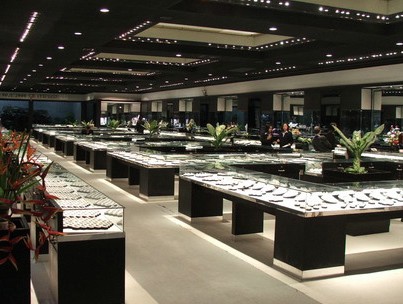Retail Safety and Security or the Managers Special

By Randall Milks | Submitted On February 20, 2011
Businesses exist to make money. Some are more successful at this endeavor than others, but because money is a factor, each and every one of them is a potential target for some type of criminal activity and each employee is a potential victim.
According to the Bureau of Labor Statistics, homicide is the second leading cause of death to American workers, claiming the lives of 912 workers in 1996 and accounting for 15 percent of the 6,112 fatal work injuries in the United States (BLS, 1997). Violent incidents at work also resulted in 20,438 lost work-day cases in 1994 (BLS, 1996).
Additionally, each year millions of dollars is paid out in compensation claims to victims of violence that occurred in their place of employment.
From 1980 to 1992, the overall rate of homicide was 1.6 per 100,000 workers per year in the retail industry, compared with a national average of 0.70 per 100,000 workers (NIOSH, 1996). Job-related homicides in retail trade accounted for 48 percent of all workplace homicides in 1996 (BLS, 1997).
The wide diversity within the retail industry results in substantial variation in levels of risk of violence. Homicides in convenience and other grocery stores, eating and drinking places, and gasoline service stations constituted the largest share of homicides in retail establishments (BLS, 1997).
From 1990 to 1992, the highest annual homicide risks among retail industries were as follows:
Liquor stores: 7.5 per 100,000 workers
Gasoline service stations: 4.8 per 100,000
Jewelry stores: 4.7 per 100,000
Grocery stores (including convenience stores): 3.8 per 100,000
Eating and drinking places: 1.5 per 100,000 (NIOSH, 1996).
Who were the perpetrators of these violent acts? They were fellow employees, clients or customers, family members, friends and complete strangers who were on the premises to commit a crime such as robbery, theft or worse.
While there may not be a history of violent incidents having ever occurred at YOUR establishment, it is important to understand the likelihood maybe low...but the possibility is 100%, EVERYDAY!
There are a number of factors that make employees of retail establishments and other businesses prime targets:
Unrestricted access by the public
Cash on the premises
Working away from the establishment itself
Late or extended hours
Working alone
Young, inexperienced employees
The most likely risks for employees and businesses involve robbery and assault, shoplifting or theft, belligerent customers and clients and otherwise members of the public that are unwelcome.
In some cases, actual physical assault and resulting injury could have been avoided, but the situation escalated as a result of the employee's actions. This is not to say that the employee brought the action upon him or herself, but out of a desire to stop a crime, protect the business and its assets, or simply acting out of fear or instinct, the employee put themselves at risk.
Most employees want to do a good job and do the right thing, and while their heart may be in the right place, it must be understood that it is much safer for everyone if the employee practices proper security and safety procedures and situational awareness. Business owners, supervisors and managers do not expect their employees and co-workers to be a hero. Money and property can be replaced; a life cannot.
The security industry has a rule of thumb called the "Three D's of Security" These three D's are 1- Deter, 2- Detect and 3- Delay. The first, "Deter", relates to deterring an offender from attempting to commit a crime at your establishment. Any measures you can take that would cause a potential criminal to decide that the risk of being caught outweighs the rewards of getting away with the crime. Examples would be efficient lighting inside and outside the business, visible cameras and signs stating that surveillance is in effect. Signs stating that the clerk or cashier DOES NOT have access to the safe may cause a robber to consider another target. Acknowledging each customer that enters a retail establishment is not only good customer service, but it lets everyone know they have been seen and are likely being observed which may deter potential shop lifters.
The second "D", Detect refers to being discovered. The sooner a crime is discovered the sooner action can be taken to decrease the damage caused by the act. Often deter and detect overlap. The use of cameras and alarms can both discourage criminals as well as detect them should they choose to ignore their presence. The same goes with convex mirrors. They are obvious to customers and potential thieves and they also assist the staff in detecting deviant behavior.
The third "D", delay suggests that management should take physical measures to slow down a crime. The use of heavy duty security locks, superior lighting and certain landscaping practices can cause a criminal to take longer than anticipated to commit a certain crime. There is no such thing as an invincible lock, but many are better than others and when it comes to security locks, there are more bargains at $100 than there are at $10. By delaying a criminal, the chances of detection are enhanced; the smarter offender may realize this and convince him or her to seek a target that has a higher chance of reward and a lower chance of being caught.
The 3D's can be applied to every business and residence. Consider each of the 3D's for the perimeter of your establishment or facility. The perimeter would be considered the boundary of your responsibility. This would include parking for both clients and employees, the walkways to and from all entrances as well as outbuildings and refuse collection points.
The exterior would be all entrances, windows and rooftop access points. Rooftops by the way are fast becoming the most popular access point for burglaries of business establishments. The burglars, once on the roof of a flat top building are, for the most part, out of the line of sight and sound of passersby and patrols and with the right tools have ample time to cut a hole through the roof for unencumbered access to the interior. This aspect of exterior security should be included when considering installation of alarm systems.
Interior considerations include the sales floor area, the cash/clerk station and anywhere customers and clients are likely to go as well as places in the establishment where they can possibly hide.
Putting the 3D's to work on the perimeter, exterior and interior of your establishment will greatly reduce the likelihood of your business being targeted while at the same time enhance the chances of an offender being apprehended for a crime should he follow through on his or her attempt.
Prior to implementing any security or safety program for your business it is important to see where you currently stand. An assessment should be conducted to determine what you have in place that is effective, non-effective or could be modified to make effective. It is recommended that the services of a security consultant be retained to assist in the evaluation. While the cost may seem at first to be somewhat prohibitive, the reduction in injury, liability and likelihood of fewer compensation claims far outweighs initial monetary concerns.
After your assessment is complete you'll have to prioritize the recommended solutions to identified problems. A simple but effective priority matrix consists of three categories: MUST DO, SHOULD DO and NICE TO DO.
Prioritizing helps you determine issues that need to be addressed first. When you are done, everything on your list should not only enhance safety and security but boost the confidence of your employees as well.
Once you are satisfied that all reasonable concerns have been addressed, you will need to develop a Safety & Security Plan (SSP)
Because there is no overall blanket answer the plan must be tailored to the specific needs and concerns relative to your establishment. Development of the plan should begin with addressing both Physical Controls and Procedural Controls.
Physical control measures can include equipment and device installation, such as cameras, mirrors, and monitors, arrangement of furnishings and other measures that are permanent or "fixed".
Procedures in the work place or lack of procedures are a definite determining factor in worker safety and security. With well thought out procedural controls, workers are able to prevent most accidents and mishaps on the job and avoid or prevent violent incidents from occurring. A procedure, no matter how well intended is of no use if it is not followed. Once a procedure has been implemented for a specific task, time frame, job, etc, it must be enforced. Rules, policies and procedures without enforcement are only advice. Too often, good advice is only followed if it is convenient.
Staff needs to be trained on all procedures before they start a job and the procedures should be job specific and not general in nature. There should be separate written procedures for duties such as:
Money deposits
Opening/closing/cashing out the till
Trash disposal
The safety and security risk involved in the specific job should be considered in the procedure. Some jobs inherently carry more risk than others and staff needs to follow the procedures specific to that job:
Working alone
Handling money
Working late hours
Additionally there needs to be emergency plans and procedures in place in case of fire, natural disaster or....a violent incident. The procedures should also include necessary action for the staff member to take after the incident.
Procedural controls also include dealing with customers and clients. Staff should be trained on techniques effective on discouraging theft and robbery; eye contact, greetings, offering assistance, observing unusual behavior, etc.
There is no need for these procedures to be complicated. On the contrary, they should be as clear, concise and as simple as possible, while still being effective. Ask for input from employees and co-workers. They are the ones doing the job under the conditions that may put them in danger. They will likely have ideas that can be thought of only by someone in their position. Make your staff and employees part of the team.
Randall Milks is owner and director of Ran-Mar Services, Effective Risk Reduction, a private and public safety training and service provider. He can be reached at rmilks@ranmarservices.com or at his website: [http://www.ranmarservices.com].
Article Source: http://EzineArticles.com/expert/Randall_Milks/935170






